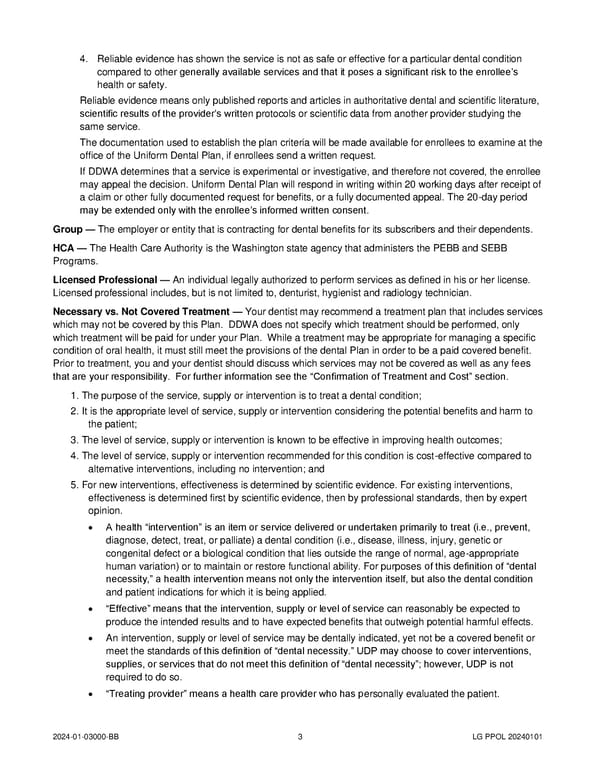4. Reliable evidence has shown the service is not as safe or effective for a particular dental condition compared to other generally available services and that it poses a significant risk to the enrollee’s health or safety. Reliable evidence means only published reports and articles in authoritative dental and scientific literature, scientific results of the provider’s written protocols or scientific data from another provider studying the same service. The documentation used to establish the plan criteria will be made available for enrollees to examine at the office of the Uniform Dental Plan, if enrollees send a written request. If DDWA determines that a service is experimental or investigative, and therefore not covered, the enrollee may appeal the decision. Uniform Dental Plan will respond in writing within 20 working days after receipt of a claim or other fully documented request for benefits, or a fully documented appeal. The 20-day period may be extended only with the enrollee’s informed written consent. Group — The employer or entity that is contracting for dental benefits for its subscribers and their dependents. HCA — The Health Care Authority is the Washington state agency that administers the PEBB and SEBB Programs. Licensed Professional — An individual legally authorized to perform services as defined in his or her license. Licensed professional includes, but is not limited to, denturist, hygienist and radiology technician. Necessary vs. Not Covered Treatment — Your dentist may recommend a treatment plan that includes services which may not be covered by this Plan. DDWA does not specify which treatment should be performed, only which treatment will be paid for under your Plan. While a treatment may be appropriate for managing a specific condition of oral health, it must still meet the provisions of the dental Plan in order to be a paid covered benefit. Prior to treatment, you and your dentist should discuss which services may not be covered as well as any fees that are your responsibility. For further information see the “Confirmation of Treatment and Cost” section. 1. The purpose of the service, supply or intervention is to treat a dental condition; 2. It is the appropriate level of service, supply or intervention considering the potential benefits and harm to the patient; 3. The level of service, supply or intervention is known to be effective in improving health outcomes; 4. The level of service, supply or intervention recommended for this condition is cost-effective compared to alternative interventions, including no intervention; and 5. For new interventions, effectiveness is determined by scientific evidence. For existing interventions, effectiveness is determined first by scientific evidence, then by professional standards, then by expert opinion. • A health “intervention” is an item or service delivered or undertaken primarily to treat (i.e., prevent, diagnose, detect, treat, or palliate) a dental condition (i.e., disease, illness, injury, genetic or congenital defect or a biological condition that lies outside the range of normal, age-appropriate human variation) or to maintain or restore functional ability. For purposes of this definition of “dental necessity,” a health intervention means not only the intervention itself, but also the dental condition and patient indications for which it is being applied. • “Effective” means that the intervention, supply or level of service can reasonably be expected to produce the intended results and to have expected benefits that outweigh potential harmful effects. • An intervention, supply or level of service may be dentally indicated, yet not be a covered benefit or meet the standards of this definition of “dental necessity.” UDP may choose to cover interventions, supplies, or services that do not meet this definition of “dental necessity”; however, UDP is not required to do so. • “Treating provider” means a health care provider who has personally evaluated the patient. 2024-01-03000-BB 3 LG PPOL 20240101
 Uniform Dental Plan COC (2024) Page 7 Page 9
Uniform Dental Plan COC (2024) Page 7 Page 9